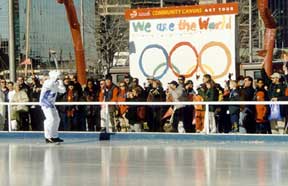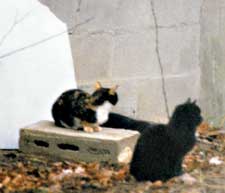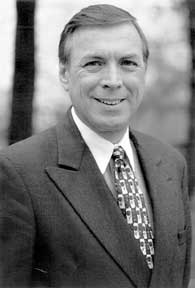|
|
 On Terra Firma, Swimmer Stewart Carries the Torch On Terra Firma, Swimmer Stewart Carries the Torch
If Joe Stewart holds any element sacred, it’s water. But on December 22, the Bay’s busiest open-water swimmer adjusted to solid ground.
Buffeted by a crisp breeze, Stewart jogged through Baltimore’s Federal Hill neighborhood and down two blocks gifted with views of historic rowhouses, downtown towers, the Ravens’ stadium, Federal Hill itself and the Inner Harbor. It’s unlikely he noticed any of this, though, for he was fully focused on what he was carrying: the Olympic Torch.
Stewart, a water activist for 11 of his 12 years of swimming rivers and estuaries, ran at the core of a motorcade of shuttle buses, motorcycles and cars in Baltimore’s Olympic Torch Relay. Holding the flame aloft and looking pleasantly dazed, he approached the southwest corner of Federal Hill. Amid a hail of encouragement and congratulations, Stewart lit the torch of the next runner.
“I was completely zoned out,” said Stewart of his .2-mile Olympic Torch Relay. “There was a guy in blue running along next to me who was encouraging me on, but I wasn’t even there. I was so high — I was nowhere. It felt wonderful.”
Even the pep rally that greeted him could not stir him from his transcendental moment. “I was having a hard time focusing on who was there. I heard lots of people yell. I still was kind of not there. I still wasn’t ready to come down.”
It was a moment he was primed for.
Stewart, who has founded and organized long-distance swims throughout the Bay to benefit environmental and HIV/AIDS groups for the past 11 years, passed that torch to new organizers last year.
 |
‘When I read about the Olympic torch relay,’ said Joe Stewart, far right, ‘I thought it would be a spiritual experience, to be connected to the rest of the world with this flame.’
photo by Mark Burns
|
“When I read about t
he Olympic torch relay, I thought this would be a nice culmination of my work,” said Stewart. “I thought it would also be a spiritual experience, to be connected to the rest of the world with this flame. It is somewhat overwhelming in that it really does feel like I’m part of a link with the world.”
To link him in, friends, family and coworkers chipped in with nominations. After winning the spot, Stewart scoped out the site where he would be running. He was smitten.
“It’s a beautiful spot,” said Stewart. “Symbolically, I’m where I want to be.”
He did a run-through of his relay leg with one arm held up. He tried on his uniform — a white running outfit with jacket and fleece cap, all emblazoned with Olympic rings. Otherwise, his only preparation time was spent cultivating butterflies in the stomach.
“I got a little nervous, even though it’s only two blocks,” he said. “It puts a lot of pressure on you. With all these people coming out to see you, you’ve got to make sure you don’t drop the torch.”
He did not drop the torch, and the flame found its way safely through the Baltimore leg’s 35 relay runners — including Cal Ripken — to Rash Field ice rink. As Stewart and a crowd of hundreds watched, Baltimore ice-skater Skylaur Morris skated laps around the rink before doffing blades for sneakers and running the anchor leg, up to the adjacent stage where he lit Baltimore’s Olympic Cauldron.
Grounded once again, Stewart is looking forward to his next next long distance swim, May 19, 2002, across the mouth of Patapsco River, for which he’s now gathering pledges to benefit Sierra Club of the Patapsco.
He’ll keep the torch — minus the aerosol propane cartridge — as a memento.
— Mark Burns
Worries Aside, Cove Point Gas Plant Gets a Green Light

By late summer, a very different kind of craft could be displacing fishing boats at the Calvert County honey hole popularly called the Gas Docks.
Under a new federal ruling, football field-sized tankers arriving with liquified natural gas from faraway ports could be again docking at the giant off-shore assemblage of pipes and platforms just south of the Calvert Cliffs nuclear power plant.
Unless the Coast Guard raises objections, Cove Point LNG could be up and running in eight months, Williams Companies, the Tulsa energy company pushing to reopen the plant, predicted.
The go-ahead came from the Federal Energy Regulatory Commission in the waning days of December despite worries by Maryland officials and local residents about new threats of terrorist attacks on what would be the largest natural gas-import facility in America.
Meeting on November 16, the obscure commission “reaffirmed” an earlier decision that the LNG terminal “will be operated safely.”
In the earlier decision, on October 12, the plant had already been given its operating papers. But with September 11 fresh in memory, recommissioning was halted when, in the Commission’s words, “almost all of the active parties to this case took advantage of their legal right to seek rehearing of the final approval.”
Then in November, Maryland Sen. Barbara Mikulski (D) expressed fears on the U.S. Senate floor of the potential of a devastating explosion at Cove Point. Fears of calamity are heightened by the plant’s proximity to Calvert Cliffs nuclear plant, along the shoreline about three miles away.
After Mikulski said she wanted no permits issued or ships arriving until questions were answered, the little-known federal agency that regulates energy reconvened to hear testimony from the FBI; the Nuclear Regulatory Commission; the Department of Transportation, which is responsible for overseeing the facility’s security; and other agencies, including the “interveners” who objected to the earlier decision.
“The Commission was trying to reassure the public that every issue had been reviewed and things in place to assure the safe operation of the facility,” said spokeswoman Tamara Young-Allen.
Whatever the commissioners heard in a meeting that, despite concern, was closed to the public, convinced them their earlier go-ahead should stand.
Mikulski, however, was not reassured. “FERC has once again made a premature decision on reopening Cove Point,” she said. They’re “saying ‘Damn the torpedoes, full speed ahead.’”
The commission decision clears the way for the reopening of the offshore receiving pier with two unloading locks; four storage tanks, which are landmarks on the lower Calvert peninsula; three gas-turbine generators; and an 87-mile pipeline that runs from the terminal to Loudon County, Virginia. In addition, a new 850,000-barrel storage tank can be built.
Before recommissioning can begin, the U.S. director of the Office of Energy Projects must give written approval. Shippers must also get authorization from the U.S. Department of Energy to import the gas.
The Coast Guard — which has jurisdiction over the operation of the LNG tankers through Chesapeake Bay and unloading of LNG at the marine terminal — must also sign off on safety. According to Mikulski, “The Coast Guard will not make any decision as to whether LGN tankers can safely travel into the Chesapeake Bay until after they bring all the experts together in January.”
— SOM & BL
More — Or Fewer — Kitties Next Door
 You’re more likely to have kitties next door this year than last year. As are all of us in Chesapeake Country as wild, or feral, cats multiply. You’re more likely to have kitties next door this year than last year. As are all of us in Chesapeake Country as wild, or feral, cats multiply.
Just how many feral cats live among us nobody knows for sure, as cats aren’t likely to stand still for the census takers. But we’ve been close enough to measure their spread. Bay Weekly got kitty neighbors this fall [Not Just for Kids: Vol. IX, No. 51, December 20-26]. At home, two or three of us started feeding extra kitty mouths in 2001.
You, too, may have new kitty neighbors.
“The profileration of ferals is a recurrent issue,” says Calvert Animal Welfare League’s Teresa Culver.
In some communities, feral cats are everywhere.
“In Key Largo, there’s a colony behind almost every business,” a good samaritan told Bay Weekly. As she talked, tiger cats, black cats and calico cats gathered warily for their 5pm feeding. The colony is her first stop after work every day.
Her colony at the island’s Winn-Dixie supermarket is stable. She’s lured its cats into baited cages so she could take them to be spayed and neutered. Then she’s released them to live in the wild. “They’re happy,” she says, and to ensure their happiness, she not only feeds but medicates her wild cats.
Experts agree that trapping, neutering and releasing will curtail the spread of disease and control overpopulation. Cats in the wild perceive the absence of others and reproduce more litters to account for the loss, such advocates as Alley Cat Allies and Texas A&M’s Agie Cat Project have found.
Still, the Winn-Dixie colony was anything but alone. In Key Largo, feral cats coveted our plates at dockside restaurants. They stalked the jungle of Largo Lodge. In parts of Florida, and other states as well, feral cats are epidemic.
“Feral cats are one of the largest challenges to animal welfare communities in this country,” said Karen Hopper, of PETsMART Charities in Phoenix. “It snowballs. One cat can produce thousands of kittens, so even spaying one can make a big difference.”
If you live in or near Calvert County, you’ve just gotten a bit of a buffer from the feral invasion. It comes in the form of a $6,000 grant to the county’s Feral Cat Coalition from PETsMART Charities. The non-profit arm of the 570-store pet supply giant has given $20 million since 1994 to animal welfare groups throughout the U.S. and Canada.
“We make grants to any not-for-profit animal welfare group for projects that support our mission of ending euthanasia of adoptable pets,” says PETsMART’s Hopper.
In Calvert County, the Animal Welfare League requested the funding, said Culver, “knowing it would further our life-saving efforts. With funding and education, we can stop overpopulation.”
Until this grant, the League’s feral cat resue operated “on a shoestring budget launched only by many private donations,” she said.
Now, the Calvert Feral Cat Coalition will neuter 50 cats, as well as buy traps, test for diseases and give shots. They’ll expect not only to save the lives of perfectly good cats and control the spread of ferals but also to save public money. “Taxpayer dollars are spent each time an animal control officer must respond to a wild cat call,” Culver says.
But to make a job of it, they need more help. “Land where healthy colonies can live is very much needed, especially barns and large properties,” says Culver. “And when kitten season begins in the spring, volunteers are desperately needed to help with socalizing kittens as pets.”
Information? 410/535-9300.
— SOM
Edgewater’s Aubuchon to Head National Press Group
 |
| John Aubuchon, of Edgewater, will become the third Marylander to head the National Press Club later this month. |
RRunning for other National Press Club offices, John Aubuchon, of Edgewater, would spread campaign flyers around the National Press Building in Washington and hustle votes like the candidates he watches as Maryland Public Television’s senior correspondent.
By 2001, when he decided to run for National Press Club president, Aubuchon’s tenacity was such that he didn’t even draw an opponent in the December 14 election.
Then again, other would-be presidents might not have relished running the venerable organization in tough times.
On January 18, Aubuchon will become just the third Press Club president from the Maryland media and the third broadcast journalist in the job. He’ll be inaugurated in a black-tie event that will have a distinctive Free State taste: music from Maryland jazz vocalist Ethel Ennis and Chanteymen from the U.S.S. Constellation at Baltimore’s Inner Harbor.
Perhaps then Aubuchon will realize what he’s gotten himself into.
“I’m told it’s like working another full-time job,” he said.
Indeed, Aubuchon will be spending many hours on the road between Edgewater, Washington and the Maryland Public Television studio in Owings Mills. For the helm of the National Press Club takes considerably more than a ceremonial hand. Especially now, when many of the larger media are shaken from slumping ad revenues just as they’ve spent a bundle on gathering the news that people have been craving since the upheaval of September 11.
As Aubuchon takes the reins of the 94-year-old organization, newspapers, broadcast outlets and Internet operations are less willing to buy $450 memberships for staff. Nor will corporate media entities, (many eager to preserve their double-digit annual profit growth), so cheerfully contribute to the non-profit Press Club for its continuing education and development programs.
For instance, the Press Club co-sponors writing workshops and even refresher courses on taking notes — at a time when the most technologically swift reporters are pulling out fold-up keyboards at news events and plugging them into Palm Pilots to capture events.
Press Club heads rub shoulders with the world’s elite. Over the years, Nikita Khrushchev, Winston Churchill and Indira Gandhi have chosen the Press Club to make news. A non-stop series of luncheon speakers, many of them introduced by the president, includes more than politicians: Entertainer Dolly Parton has spoken at the Press Club, and actor Kirk Douglas will be the guest in the club’s 14th Street building on January 16.
Aubuchon, who was vice president, takes over for Dick Ryan, of the Detroit News, who focused heavily on press freedoms during his one-year term.
Aubuchon says that he will continue that work and also devote himself to reaching out to broaden the club membership, hopefully with more journalists from around the country. As it stands, about 1,000 of the 4,400 members work outside the Washington-Baltimore area.
Aubuchon is eager, he said, to perform the ritual of handing out journalism awards that the Press Club administers.
“It is rewarding to hand awards to some of the best in our business. We in journalism do what we do because we love it,” he said.
Aubuchon, a St. Louis native, has been a Marylander since 1956. He and his wife, Akemi, have lived in Edgewater for 16 years. His father, retired naval officer Robert W. Aubuchon, also lives in Edgewater.
Aubuchon is lead reporter for legislative coverage at Maryland Public Television, where he has worked since 1996. He is a former White House correspondent and covered the Vietnam War for the Armed Forces Radio and Television Service.
He has been active in local civil affairs, heading his community associations in Southdown Shores and Beverly Beach.
It’s been more than a half-century since a Marylander headed the journalists’ organization. The last was the Baltimore Sun’s Joseph H. Short Jr. in 1948. The other Marylander to hold the job was J. Fred Essary of the Baltimore Sun in 1928.
The Press Club has been around since 1909, when 32 reporters — all men in those days — ponied up a total of $300 and framed a constitution.
Even as its members exposed the foibles of others, the Press Club has not avoided scandals of its own. The club did not admit African Americans until 1955, and women were not welcome until 1971.
— BL
Way Downstream ...
In Delaware, the new Perdue Farms fertilizer factory to recycle thousands of tons of polluting manure on the Delmarva Peninsula has reached full production. The plant at Seaford has begun sending pellets of the chicken wastes to the Midwest to fertilize croplands, the News Journal reported last week …
In Japan, an infamous sanitation worker known as the ‘God of Garbage’ was arrested last week after accosting a tavern owner for not properly separating his trash. Japan has strict rules for recycling and separating food waste from general waste, but Mizuo Tamura, the Kajiki city employee, allegedly went too far when he pulled a knife on the tavern owner. “He wasn’t separating his rubbish properly,” Tamura said in his own defense …
In Michigan, a heron flew south for the winter — in a jet. The green heron, which had suffered a broken leg, was flown to the Pelican Harbor Seabird Sanctuary in Miami after an anonymous donor took pity. The sanctuary has nursed many birds back to form, among them screech owls and sandhill cranes. Come spring, that heron will be expected to fly back to Kalamazoo — via its own wings …
 Our Creature Feature comes from Pompano Beach, Fla. where we have discovered what every journalism student is told to seek: a Man Bites Dog story. Only this one is real. Our Creature Feature comes from Pompano Beach, Fla. where we have discovered what every journalism student is told to seek: a Man Bites Dog story. Only this one is real.
According to news reports last week, Vader, a four-year-old German shepherd employed by the Broward County Sheriff’s Department, suffered injuries to his right eye when he was bitten in the face while helping to chase down an allegedly drunken driver.
The driver, Dana Murphy, 28, of Virginia, faced a pile of charges, among them injuring a police dog. The reports said that Vader was taking antibiotics and would return to work shortly.
Copyright 2002
Bay Weekly
|